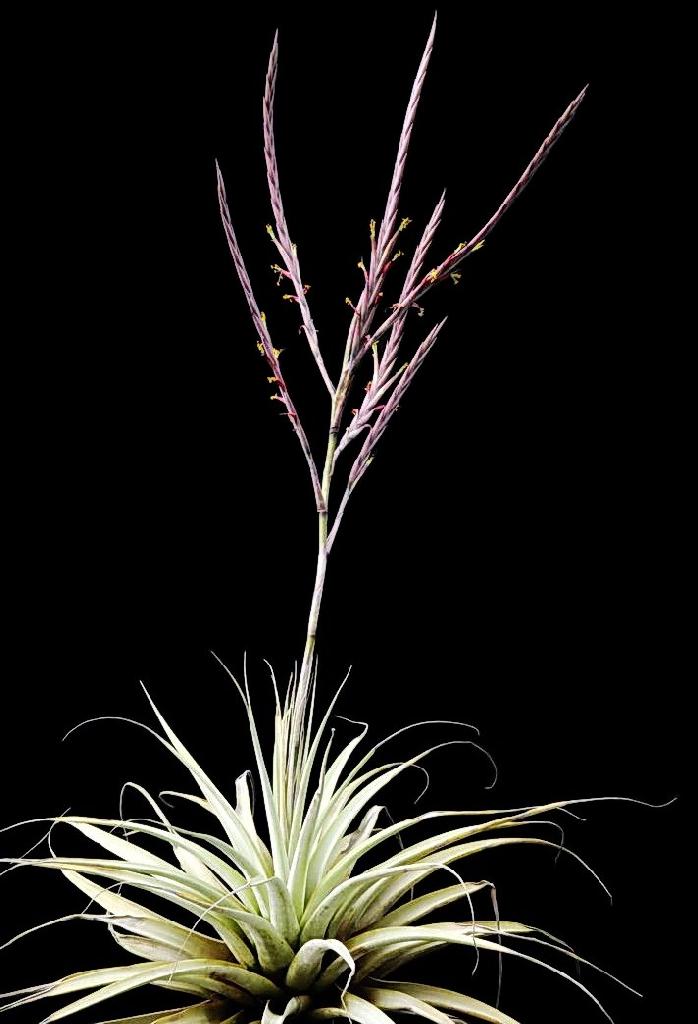
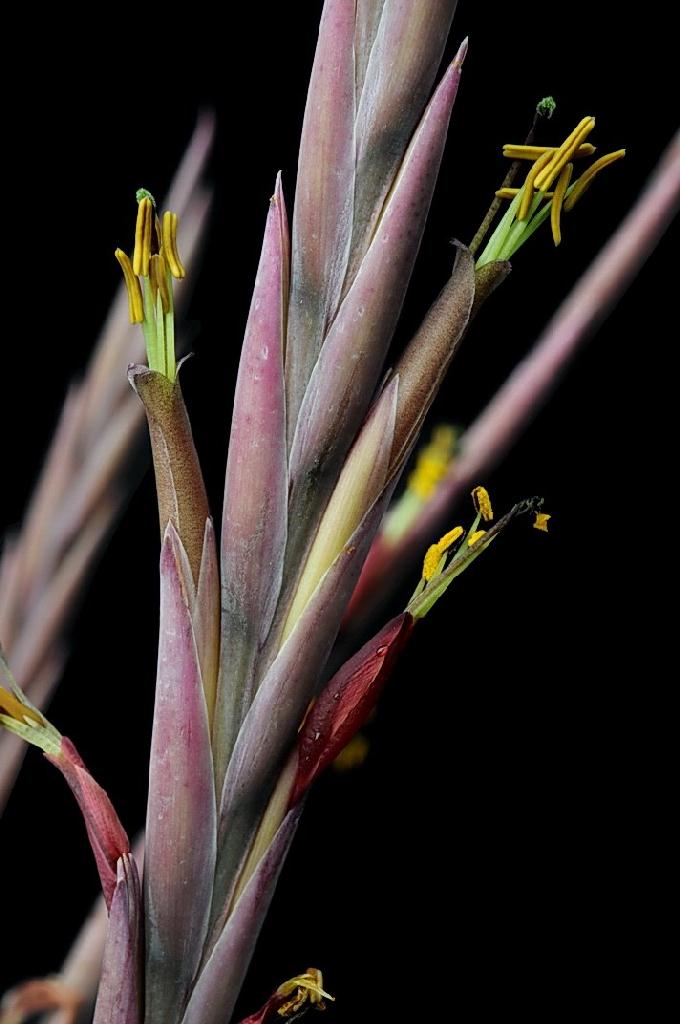
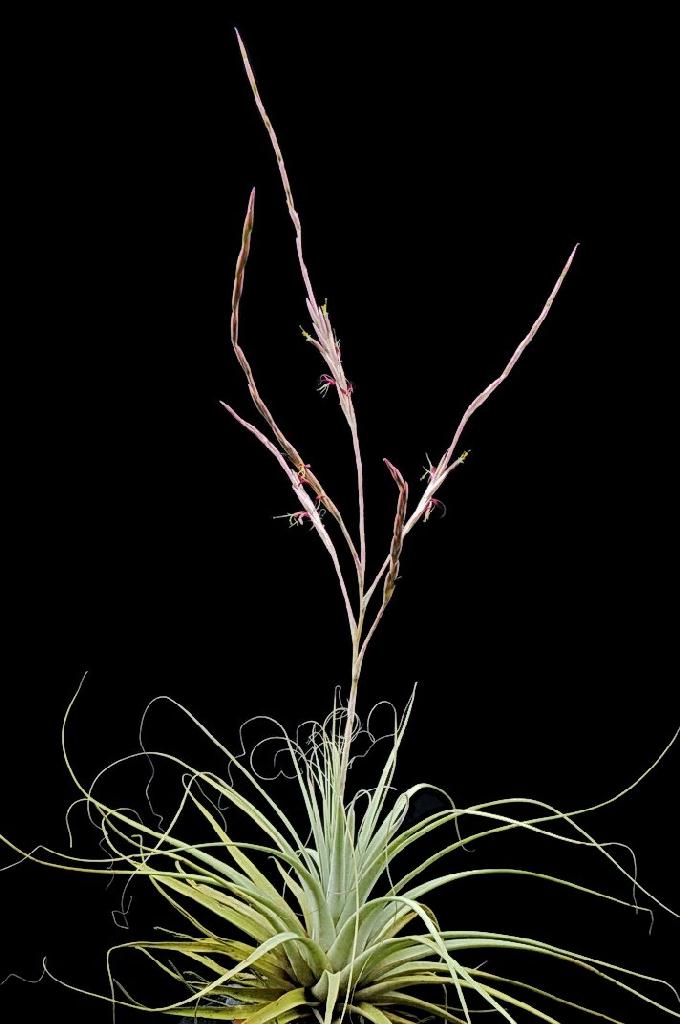
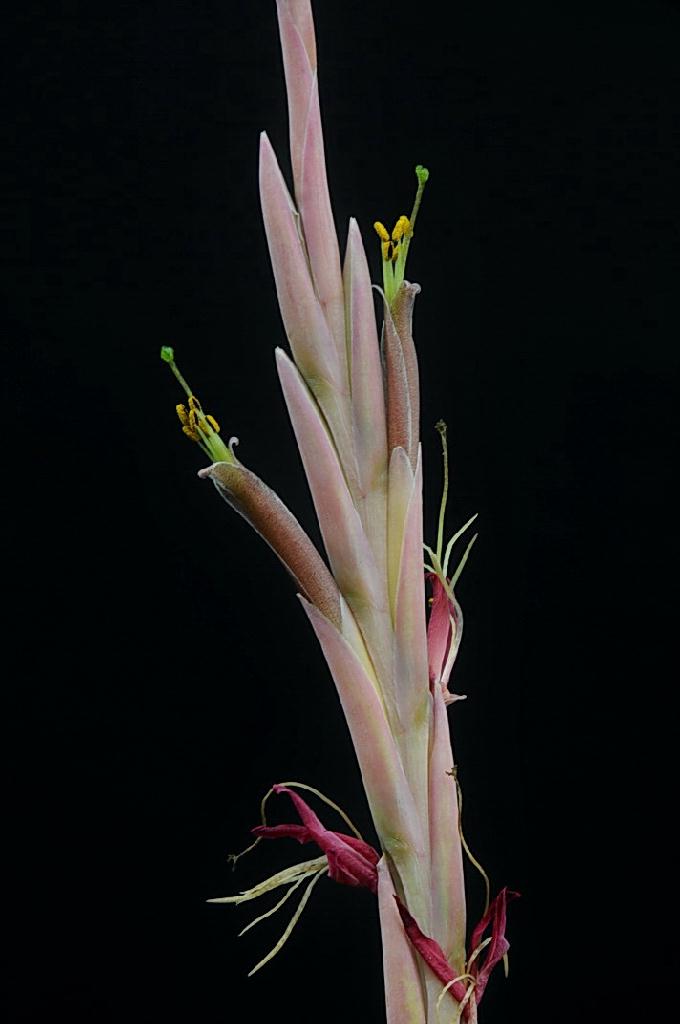
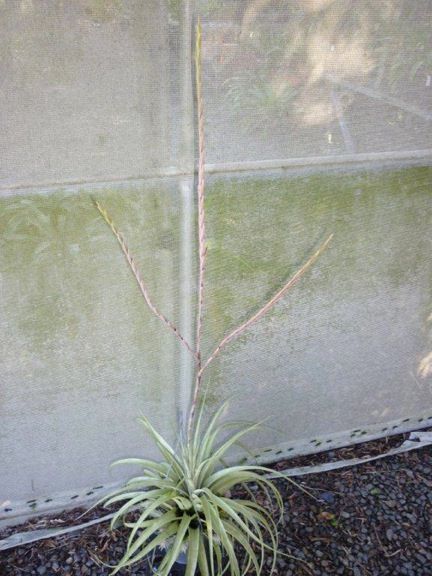
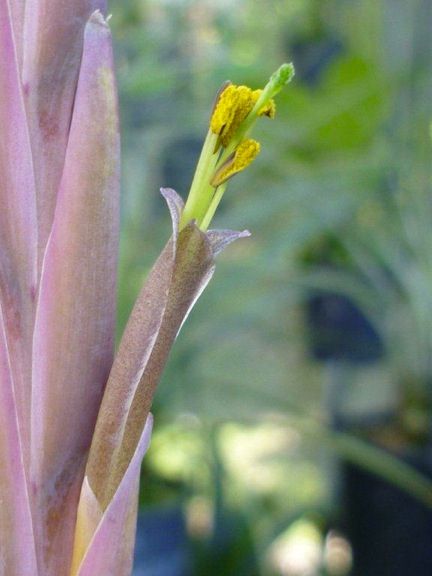
Botanical description, thanks to Derek Butcher. (See also T. hitchcockiana).
Tillandsia cereicola Mez, Repert Nov. Sp. 3:34. 1906, see Grant in Phytologia 75(2): 170-175. 1993
Vriesea cereicola (Mez) L. B. Smith, Phytologia 6: 1963.194. 1958; 8: 504,
Vriesea lopezii L. B. Smith, Phytologia 4: 218, pl. 2. figs. 8-10. 1953. Type. Samne to Caminche, Trujillo, Libertad, Peru, Lopez 846 (TRP, US), 21 May 1952.
Desc from S&D p 1249
Plant stemless, growing in dense masses, flowering 1 m high with the inflorescence extended.
Leaves about 12, densely utriculate-rosulate, 3 dm long;
Sheaths broadly elliptic, merging into the blades, dark castaneous toward base;
Blades narrowly triangular, attenuate to a thick angulate-subulate apex, 4 cm wide, covered with coarse subspreading ferruginous-incanous scales.
Scape arching-decurved, about equaling the leaves, stout;
Scape-bracts tubular-erect, slightly exceeding the internodes, glabrous or subglabrous, the lower short-laminate, the upper obtuse.
Inflorescence pendulous, of 1-4 spikes, subpinnate, 4 dm long;
Primary bracts but slightly larger than the floral bracts, enfolding the base of the spike;
Spikes linear-lanceolate, 3 dm long, 15 mm wide, more or less complanate, 18-flowered, bearing several sterile bracts at base;
Rhachis undulate, angled, excavated next the flowers.
Floral bracts imbricate and nearly concealing the rhachis, lanceolate, obtuse, 35 mm long, much exceeding the sepals, ecarinate, straight toward apex, green to dull rose, chartaceous, nerved and minutely white-pruinose along the margin, elsewhere glabrous; pedicels 3-4 mm long, obconic;
Flowers 52 mm long (including the pistil).
Sepals lanceolate, acute, 20-25 mm long, ecarinate, coriaceous, even, glabrous;
Petals tubular-erect, violet;(Green with violetish speckles – Rauh!)
Stamens and pistil exserted.
Type. Weberbauer 3025 (holotype B, F photo 11487), near Caraz, Ancash, Peru.
DISTRIBUTION. Saxicolous and epiphytic, dry rocky slopes, 700-2200 m alt, northwestern Peru.
PERU. CAJAMARCA: Jaen, Aug 1956, Rauh P-331 (US); Catache to Cumbil, Santa Cruz, 21 May 1965, Lopez & Sagastequi 5191 (TRP, US); Pampa Huangavilca, Val1e del Crisnejas, Cajabamba, 28 May 1965, Lopez & Sagastequi 5537 (TRP, US). LIBERTAD: Chaullacocha, Samne to Otuzco, 28 May 1960, Ferreyra 14100 (US, USM); Hacienda Chorobamba, Bolivar, 3 Jun 1960, Lopez & Sagastequi 3362 (TRP, US). ANCASH: Valley of Rio Santa, Aug 1956, Rauh P-270 (US); Canon del Pato, Huallanca to Caraz, Huaylas, 3 Jun, Ferreyra 14591 (US, USM); across Rio Santos from Mancos, 13 Apr 1970, C. E. Smith, Jr. 4953 (US); Caraz, 22 May 1970, Lopez et al 7394 (TRP, US).
VRIESIA LOPEZII L. B. Smith. Phytologia 4: 218,pl. 2. Figs. 8-10. 1953.
A V. barclayana (Baker) L. B. Smith, cui affinis, vaginis foliorum indistinctis, inflorescentia gracillima tereti, bracteis florigeris tenuibus nervatis glabris differt.
Flowering plant 7 dm. high;
leaves erect, 4 dm long, covered with gray subappressed scales;
sheaths very small and inconspicuous;
blades linear-triangular, filiform-acuminate, 2 ca. wide;
scape erect, 4mm in diameter, glabrous;
scapebracts erect. imbricate, elliptic, the lower ones lepidote and with a short foliaceous blade, the upper ones obtuse and glabrous;
inflorescence simple. terete, 3dm. long, 7 mm. in diameter, glabrous; rhachis broadly winged and enfolding the bases of the flowers;
floral bracts like the upper scape-bracts 3cm. long. imbricate. exceeding the sepals, ecarinate, thin, nerved, green with purplish apices;
pedicels obconic, 4 mm. long;
sepals lanceolate, acute, 23 mm. long, ecarinate, thin,
Petals 35mm long, the blades elliptic, purple, the claw bearing 2 large oblong acute scales; stamens exserted.
Plate II. fig. 8; Plant: 1/10; fig. 9; Sepal x 1; fig. 10; Petal x 1.
Type in the U. S. National Herbarium, No. 2,100,204, collected at Samne-Casminche, Province of Trujillo, Department of La Libertad, Peru, altitude 1,600 meters, May 21, 1952. by A. Lopes M. (No. 846).
Mez 1935
Peru: Dept. Ancachs, bei Caraz (Weberbauer n. 3025).
87. T. cereicola Mez in Fedde, Repert. III. (1906) 34.
Metralis. Folia multa, dense utriculatim rosulata, ad 0,3 m longa, super vaginam ad 40 mm lata, inde in apicem crasse angulato-subulatum sensim angustata, rigida, lepidibus conspicuis ferruginascenti-incana. Scapus validus, arcuatim decurvus, folia subaequans, dense vaginis glabratis vel subglabratis, apice haud vel vix laminigeris summis rotundatis, tubulosis, internodia paullo superantibus indutus. Inflorescentia pendula, sat elongata, ad 0,4 m longa, e spicis 3-4 subaequalibus, ad 18-floris, utrinque acutis, flabellatis, usque ad 0,3 m longis et 15 mm latis mihi visis, optime complanatis composita; bracteis primariis quam spicae multo brevioribus; bracteis-florigeris strictissime erectis, manifeste imbricatis, ad 13 mm distantibus, chartaceis, glabris, ad 35 mm longis, sepala longe superantibus. Flores strictissime erccti, ad 52 mm longi; sepalis subaequilaliter liberis, coriaceis, glabris laevibusque, haud carinatis, acutis, ad 30 mm longis. Petalis violacea, ad 43 mm longa, tubulose erccta, quam stamina breviora.
Translated by Butcher
A metre high.
Leaves many, forming a dense rosulate utriculum, to 30cm long, above the sheath to 40 mm wide, then gradually narrowing to a thick angular subulate tip, stiff, conspicuous brown grey lepidote.
Scape stout, arcuate decurved, almost equalling the leaves, dense with glabrous to subglabrous scape bracts, with the tips of the blades not at all or a little rounded at the tip, tubulous, a little exceeding the internodes.
Inflorescence pendulous, moderately elongate, to 40cm long, with 3-4 subequal spikes, to 18-flowered, both sides acute, fan-like, up to 30cm long and 15 mm wide that I saw, mostly complanate;
primary bracts many times shorter than the spikes;
floral bracts very strictly erect, clearly imbricate, to 13 mm apart, papery, glabrous, to 35 mm long, long exceeding the sepals.
Flowers very strictly erect, to 52 mm long;
sepals subequally free, leathery, slightly glabrous, not at all carinate, acute, to 30 mm long.
Petals violet, to 43 mm long, tubular erect, shorter than the stamens.
Peru: Dept. Ancachs, near Caraz (Weberbauer n. 3025).